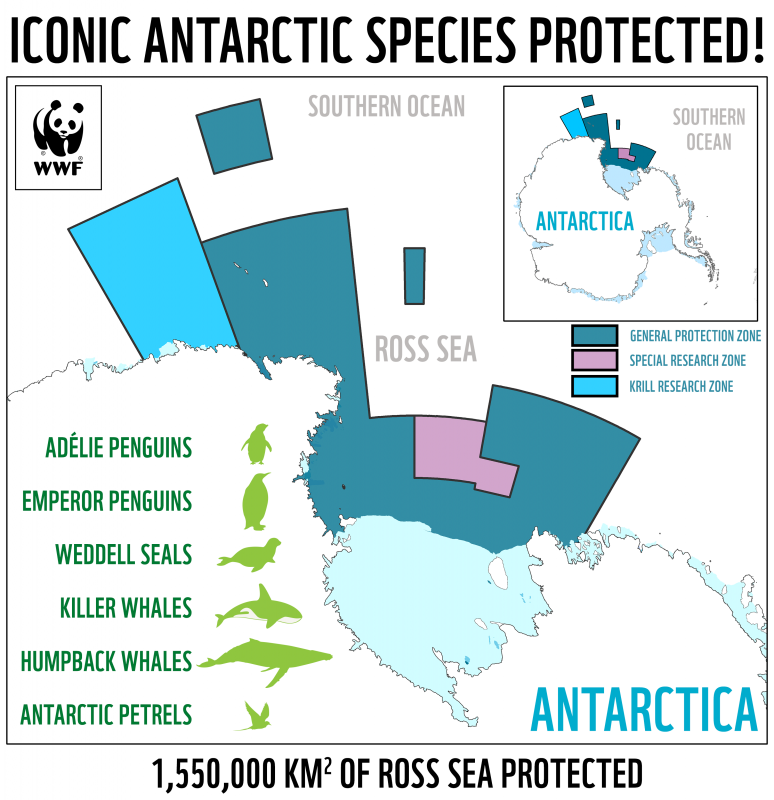The new marine protected area, expected to come into force in December 2017, will set out to protect some 600,000 square miles of the Ross Sea around Antarctica — an area more than the size of France, Germany, and Spain combined.
By Shreya Dasgupta
Ross Sea is home to more than a quarter of the world’s Emperor penguins. (Photo: Michael Van Woert/Public Domain)
Twenty-four countries and the European Union unanimously agreed last month to create the world’s largest marine protected area off Antarctica.
The deal was brokered at the meeting of the Commission for the Conservation of Antarctic Marine Living Resources in Hobart, Australia.
The new marine protected area (MPA), expected to come into force in December 2017, will set out to protect some 1.55 million square kilometers (~600,000 square miles) of the Ross Sea around Antarctica — an area more than the size of France, Germany, and Spain combined.
According to the agreement, 72 percent of the marine area — nearly 1.1 million square kilometers (~417,000 square miles) — will be set aside as a “no-take” zone, in which all forms of fishing will be banned. Special zones will be carved out where harvesting of krill and other fish will be allowed only for research purposes. The protections will end in 35 years.
“The creation of the Ross Sea MPA is an extraordinary step forward for marine protection,” Secretary of State John Kerry said in a statement.

The Ross Sea marine protected area. (Map: World Wildlife Fund)
Antarctica’s Ross Sea, located south of New Zealand, is believed to be one of the most pristine marine regions in the world. A 2011 study published in Biological Conservation called it “the anthropogenically least-affected stretch of ocean remaining on Earth,” relatively free from widespread pollution, invasive species, mining, and overfishing.
The Ross Sea harbors a huge diversity of marine life. It is home to nearly half of the world’s “Ross sea killer whales,” about 45 percent of the world’s Weddell seals, around 38 percent of the world’s Adélie penguins, more than a quarter of the world’s Emperor penguins, and one third of all Antarctic petrels, according to the Pew Charitable Trusts.
To protect this relatively untouched marine area, New Zealand and the United States put forward a proposal for the creation of the Ross Sea Marine Protected Area in 2011. The proposal argued that the Ross Sea is one of the most productive areas of the Southern Ocean, and one of the few regions in the world where most of the marine top-level predator populations remain intact. It added that the Ross Sea continental shelf is also one of the best scientifically studied regions in the Southern Hemisphere.
“The existing high level of scientific understanding and information about the Ross Sea Region make it a uniquely desirable candidate for protection,” the proposal concluded.
The final agreement has come after five years of negotiations between the 25 governments. Conservationists have welcomed the unanimous decision, but have also expressed concern over the MPA’s 35-year expiration time frame.
“While this is undoubtedly good news, the agreement on the Ross Sea will expire in 35 years,” Chris Johnson, World Wildlife Fund-Australia Ocean Science Manager who attended the CCAMLR meeting in Hobart, said in a statement. “According to the World Conservation Union (IUCN) guidelines, marine protected areas must be permanent. The WWF has concerns that the Ross Sea agreement does not meet this standard. In coming years, the WWF will continue to push for the Ross Sea to become an MPA, protected in perpetuity.”
CCAMLR’s executive secretary, Andrew Wright, added: “This has been an incredibly complex negotiation which has required a number of Member countries bringing their hopes and concerns to the table at six annual CCAMLR meetings as well as at intersessional workshops. A number of details regarding the MPA are yet to be finalized but the establishment of the protected zone is in no doubt and we are incredibly proud to have reached this point.”
This story originally appeared at the website of global conservation news service Mongabay.com. Get updates on their stories delivered to your inbox, or follow @Mongabay on Facebook, Instagram, or Twitter.





